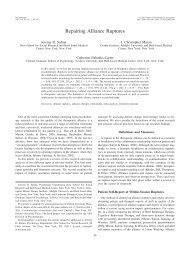Download - The Safran Lab
Download - The Safran Lab
Download - The Safran Lab
Create successful ePaper yourself
Turn your PDF publications into a flip-book with our unique Google optimized e-Paper software.
predictive abilities of the therapeutic alliance on outcome, it may have been that the<br />
relational aspects inherent in relational therapy mediated the impact of the cognitive<br />
interventions in a positive way.<br />
<strong>The</strong> results concerning the relationship between BRT therapists' use of BAP and<br />
outcome indicate that therapists' use of BAP interventions may not be advantageous.<br />
Again, this finding was non-significant, but the large effect size indicates that it may have<br />
been significant with a larger sample. Previous theorists and researchers (e.g., Wachtel,<br />
1993; Strupp, 1989) have suggested that certain dynamic interventions (e.g., transference<br />
interpretations) may be experienced by patients as punitive rather than helpful in the<br />
context of ruptures. <strong>The</strong> reason being, when a therapist responds to his or her patient's<br />
negative reactions towards him or herself by administering interventions that link the<br />
patient's past significant others to the therapist (transference interpretations), the patient<br />
may experience the interventions as invalidating. This would perpetuate the patient's<br />
negative feelings towards his or her therapist and/or therapy itself.<br />
As for the lack of significant findings and/or sizeable effects in cognitive<br />
behavioral therapy, several explanations can be offered. <strong>The</strong> finding that CBT therapists'<br />
use of CBT interventions did not contribute to poor outcome may suggest that the<br />
hypothesis was misguided. Alternatively, given the fact that CBT therapists were<br />
integrating interventions from other orientations with a high rate of overlap, it may have<br />
been that their flexible application of the treatment manual reduced the negative impact<br />
of the CBT interventions. In their study, Castonguay and colleagues (1996) observed<br />
therapists to increase adherence to their treatment interventions, which contributed to<br />
60



